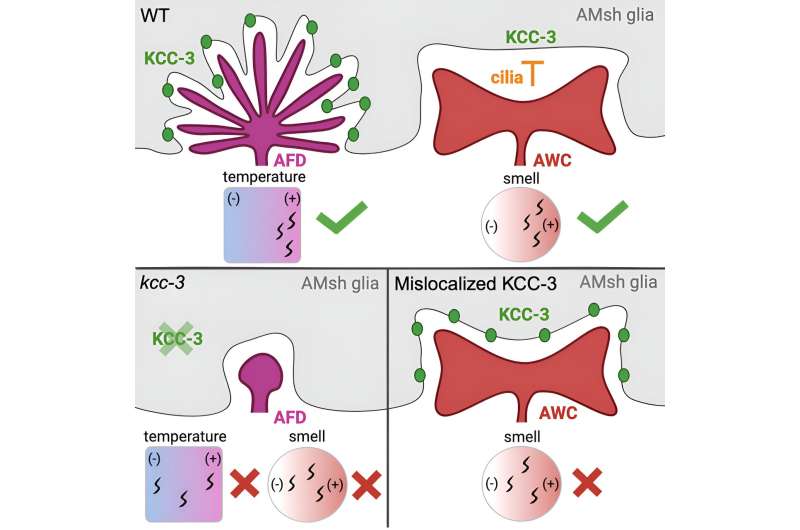This article has been reviewed according to Science X's editorial process and policies. Editors have highlighted the following attributes while ensuring the content's credibility:
fact-checked
trusted source
proofread
Molecular clusters on glial cells show they are more than our brain's 'glue'

Neuroscientists at Fred Hutchinson Cancer Center have found that an often-overlooked type of brain cell called glia has more of a role in brain function than previously thought.
In the journal Cell Reports, Fred Hutch neuroscientist Aakanksha Singhvi, Ph.D., and her team report that a single glial cell uses different molecules to communicate with different neurons. Careful clustering of these molecules ensures that the glial cell can conduct a distinct "conversation" with each neuron. Through these molecular facilitators, glia can influence how neurons respond to environmental cues like temperature and smell.
"It's the first very clear indication that a glial cell is going to put specific molecules to specific contact sites to regulate those neurons, at the single-cell level, with consequences to how the animal will behave," said Singhvi, who is an assistant professor in the Basic Sciences Division at Fred Hutch.
Glial cells make up about half of the cells in the brain, but the other half of the cells—neurons—typically get the most of our attention for their central role in our thoughts, sensations, and behaviors. Less glitzy than neurons that literally pulse with electricity, glia seemed to play a purely supporting role. Neuroscientists dismissed them as mere "glue" that helps neurons stick together, or "nursemaids" that provide neurons sustenance but not guidance.
Singhvi is among the cadre of neuroscientists leading the charge to reevaluate the importance of glia.
"In the last few years, there has been growing appreciation that glial cells may contribute to many diseases of the brain, from epilepsy to Alzheimer's," Singhvi said. "To have a more holistic and clinically relevant picture of brain function, we need to go back to basics and more fully understand how glia and neurons work together."
To unearth glial cells' basic biology, Singhvi helped develop the use of Caenorhabditis elegans, which are tiny, transparent worms (also called nematodes). Each worm has exactly the same number of cells, including 302 neurons per animal and only 56 glia. While we may seem to have little in common with worms, their neurons, and glia work much like ours.
Singhvi and Sneha Ray—first author of the study and a graduate student in Singhvi's lab—focused on one of these glial cells called amphid sheath (AMsh) to see how they interacted with a sensory neuron called AFD, which senses temperature for C. elegans.
Using high-powered microscopes to zero in on individual neurons and glia, the researchers looked for a protein called KCC-3 that Singhvi had previously discovered helps with signaling across cell membranes. The researchers quickly saw that KCC-3 was not distributed equally along the glial cell's membrane. Instead, the protein clustered in one spot along the interface between the glial cell (AMsh) and the sensory neuron (AFD).
"We realized it's sitting next to the temperature-sensing neuron—but not any of the others—which is essentially the glial cell knowing a half a micron [millionth of a meter] difference between the two neurons," Singhvi said.
The team detected at least three types of molecular clusters that connect the AMsh glia to different sensory neurons.
Ray and Singhvi also found that even though every neuron enveloped by AMsh senses a different environmental cue, the glial cell can help integrate information across circuits and allow neurons within one sensory circuit (like temperature) to influence the function of neurons within a different circuit (like those that smell specific odors). In this way, a single glial cell can help the worm respond to the bigger environmental picture instead of merely helping neurons relay individual external cues.
"When you think about what it takes to be a nematode, it's very complicated," Singhvi said.
What does a worm do when it encounters a tantalizing scent that signals food—right when its environment starts getting dangerously warm? It must balance these different inputs and make a decision.
"The worm won't burn—it's too smart to burn," Singhvi said.
And the compartmentalization that she and Ray uncovered is likely critical to a nematode's—or human's—ability to weigh important factors like heat and smell, she said. This allows the animal to have multiple circuits working properly at the same time without confusing cross-connections.
For possible applications to human brain health, Singhvi noted that the same KCC-3 protein she studies in nematodes is also essential for brain function in humans. Disruptions of KCC-3 are linked to a severe brain development disorder called agenesis of the corpus callosum or Anderman Syndrome and to seizure susceptibility and neurodegeneration. Differences in brain circuits are linked to conditions such as autism, epilepsy, and schizophrenia.
"Our brains routinely process multiple inputs or sensory cues in parallel," Singhvi said. "Our research showing that glia can be conduits between brain circuits will help us understand the different ways that the circuits can be disrupted."
More information: Sneha Ray et al, Neuron cilia restrain glial KCC-3 to a microdomain to regulate multisensory processing, Cell Reports (2024). DOI: 10.1016/j.celrep.2024.113844





















